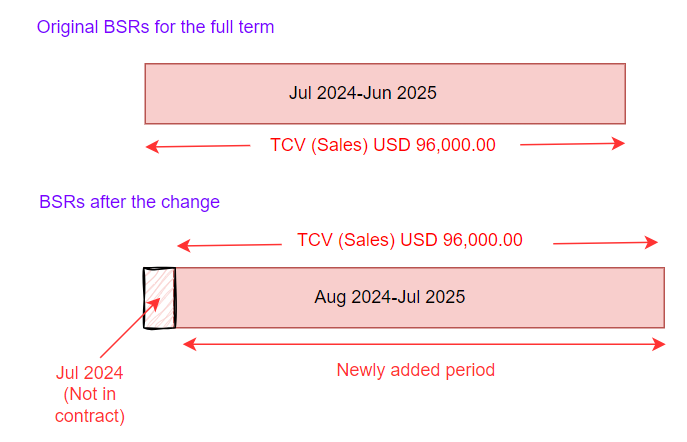The subscription is amended to push the contract's start and end dates out by one month. The amendment adds one month to the contract's end and truncates one month from the beginning of the contract. As a result, the contract term and TCV (Sales) remain unchanged after the amendment. However, the billing periods after the amendment do not align with the existing periods, disrupting the billing schedule records (BSRs).
For example, a recurring subscription with a one-time billing frequency is sold for one year with a TCV (Sales) of USD 96,000.00. The contract start date is 01-July-2024 and the end date is 30-June-2025. The setting, Proration allowed in One Time Billing is set to False.
The subscription is amended to push the start and end dates of the contract by one month. The start date is 01-August-2024 and the end date is 31-July-2024. The contract term ( still 1 year) and TCV (Sales) remain unchanged, but the newly created periods do not overlap with the existing ones. This disrupts the existing BSRs and new BSRs are created for amended periods. It is illustrated in the following diagram:

The subscription details after amendment are summarized in the following table:
| Selling Term | TCV (Sales) | Net Unit Price | Start Date | End Date | Effective Start Date | Price Type | Billing Frequency |
|---|
| 1.00000000 | USD 96,000.00 | USD 96,000.00 | 01-August-2024 | 31-July-2025 | 01-August-2024 | Recurring | One-time |
Here, the billing application receives the payload for the amendment from an order or asset line item generated in an external system. When the application processes this line item per the request, it uses the value in the Effective Start Date field on the order line item (OLI) as the billing start date (01-August-2024) from when the change is effective. As a result, the billing header fields are updated as follows:
BH ID | Current OLI | Parent OLI | ALI | Billing Start Date | Billing End Date | TCV (Sales) | Billable Amount for Current OLI | Total Invoiced Amount | Pending Invoice Amount | Status |
|---|
| BH-1 | OLI-12 | OLI-1 | ALI-1 | 01-August-2024 | 31-July-2025 | USD 96,000.00 | USD 0.00 | USD 0.00 | USD 96,000.00 | Active |
The BSRs are generated differently, based on the setting Superseding the Schedules during Asset Management is set to Always Supersede or Minimize, as shown below:
When the setting "Superseding the Schedules during Asset Management" is set to Always Supersede.
The BSRs and BSDs are:
BSR ID | BSD ID | Record Type | Category | Period Start Date | Period End Date | Actual Fee Amount | Invoice Status | Remarks |
|---|
| BSR-1 | BSD-1 | Regular | Fee | 01-July-2024 | 30-June-2025 | USD 96,000.00 | Superseded | BSR-1 is not valid, so it is superseded. |
| BSR-2 | BSD-2 | Regular | Fee | 01-August-2024 | 31-July-2025 | USD 96,000.00 | Pending Billing | Additional BSR, BSR-2 is created for a newer period because of the change operation. |
When the setting "Superseding the Schedules during Asset Management" is set to Minimize.
The BSRs are:
BSR ID | Record Type | Category | Period Start Date | Period End Date | Actual Fee Amount | Invoice Status | Remarks |
|---|
| BSR-1 | Regular | Fee | 01-July-2024 | 30-June-2025 | USD 0.00 | Superseded | BSR-1 is not valid, so it is superseded. The fee is USD 0.00, the sum of BSD-1 and its counter-BSD, BSD-1a. |
| BSR-2 | Regular | Fee | 01-August-2024 | 31-July-2025 | USD 96,000.00 | Pending Billing | Additional BSR, BSR-2 is created for a newer period because of the change operation. |
The BSDs are:
BSD ID | BSR ID | Record Type | Category | Period Start Date | Period End Date | Actual Fee Amount | Derived Invoice Status | Remarks |
|---|
| BSD-1 | BSR-1 | Regular | Fee | 01-July-2024 | 30-June-2025 | USD 96,000.00 | Superseded | BSD-1 is not valid, hence superseded. |
| BSD-1.a | Regular | Fee | 01-July-2024 | 30-June-2025 | (USD 96,000.00) | Superseded | Counter-BSD for the canceled BSD-1, BSD-1.a can be used to offset the revenue forecast from the previous BSD-1. |
| BSD-2 | BSR-2 | Regular | Fee | 01-August-2024 | 31-July-2025 | USD 96,000.00 | Pending | Additional BSD, BSD-2 is created for a newer period because of the change operation. |